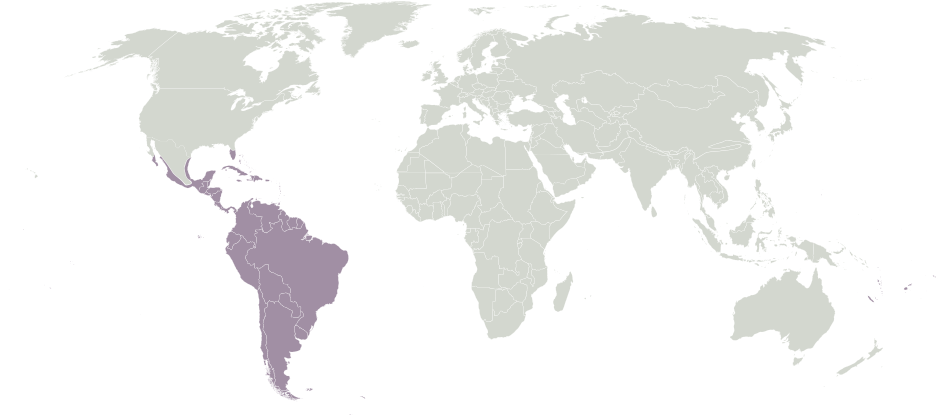Family: Megachilidae
Subfamily: Megachilinae
Tribe: Megachilini
Genus: Megachile Latreille, 1802
Subgenus: Chalepochile Gonzalez and Engel 2018
Common name: none
Megachile (Chalepochile) have a black and reddish-brown integumentintegument:
a tough, protective outer layer
covered by somewhat sparse white, yellow, and brown hairs, although they have more dense yellow hair at the end of their abdomens (Gonzalez et al. 2018Gonzalez et al. 2018:
Gonzalez, V.H., T. Griswold, and M.S. Engel. 2018. South American leaf-cutter bees (genus Megachile ) of the subgenera Rhyssomegachile and Zonomegachile , with two new subgenera (Hymenoptera: Megachilidae). Bulletin of the American Museum of Natural History 2018(425): 1-74.). Megachile (Chalepochile) males range in body length of 4–9 mm; the females are currently unknown (Gonzalez et al. 2018Gonzalez et al. 2018:
Gonzalez, V.H., T. Griswold, and M.S. Engel. 2018. South American leaf-cutter bees (genus Megachile ) of the subgenera Rhyssomegachile and Zonomegachile , with two new subgenera (Hymenoptera: Megachilidae). Bulletin of the American Museum of Natural History 2018(425): 1-74.). The species in this subgenus had previously considered members of Megachile (Rhyssomegachile) prior to the description of Megachile (Chalepochile) by Gonzalez et al. (2018).
(modified from Gonzalez et al. 2018Gonzalez et al. 2018:
Gonzalez, V.H., T. Griswold, and M.S. Engel. 2018. South American leaf-cutter bees (genus Megachile ) of the subgenera Rhyssomegachile and Zonomegachile , with two new subgenera (Hymenoptera: Megachilidae). Bulletin of the American Museum of Natural History 2018(425): 1-74.)
Note: Only males are known from this subgenus.
 preapicalpreapical:
preapicalpreapical:Male Megachile (Chalepochile) may be confused with bees within the subgenus Megachile (Rhyssomegachile) as both are small (4 to 5 mm) and have similar coarse punctationpunctation:
overall pattern of the punctures on a surface of a bee, includes size of punctures and the distance between them
on the scutumscutum:
the large segment on top of the thorax located between the wings and behind the head
(Gonzalez et al. 2018Gonzalez et al. 2018:
Gonzalez, V.H., T. Griswold, and M.S. Engel. 2018. South American leaf-cutter bees (genus Megachile ) of the subgenera Rhyssomegachile and Zonomegachile , with two new subgenera (Hymenoptera: Megachilidae). Bulletin of the American Museum of Natural History 2018(425): 1-74.). Male Megachile (Chalepochile) can be differentiated from Megachile (Rhyssomegachile) by the rounded preoccipital margin in Megachile (Chalepochile) that is carinatecarinate:
having keels or carinae
in Megachile (Rhyssomegachile) (Gonzalez et al. 2018Gonzalez et al. 2018:
Gonzalez, V.H., T. Griswold, and M.S. Engel. 2018. South American leaf-cutter bees (genus Megachile ) of the subgenera Rhyssomegachile and Zonomegachile , with two new subgenera (Hymenoptera: Megachilidae). Bulletin of the American Museum of Natural History 2018(425): 1-74.). They can also be differentiated by the length of the fringe of setaesetae:
a still hair-like structure or bristle
on the mid and hind basitarsusbasitarsus:
the segment of the tarsus that is the nearest to the body of the bee, usually the largest of all the tarsal segments that is long in Megachile (Chalepochile) and short in Megachile (Rhyssomegachile) (Gonzalez et al. 2018Gonzalez et al. 2018:
Gonzalez, V.H., T. Griswold, and M.S. Engel. 2018. South American leaf-cutter bees (genus Megachile ) of the subgenera Rhyssomegachile and Zonomegachile , with two new subgenera (Hymenoptera: Megachilidae). Bulletin of the American Museum of Natural History 2018(425): 1-74.).
Megachile (Chalepochile) species have been observed visiting flowers of Fabaceae, Papaveraceae, and Verbenaceae (Schlindwein 1998Schlindwein 1998:
Schlindwein, C. 1998. Frequent oligolecty characterizing a diverse beendash;plant community in a xerophytic bushland of subtropical Brazil. Studies on Neotropical Fauna and Environment 33(1): 46-59.; Gonzalez et al. 2018Gonzalez et al. 2018:
Gonzalez, V.H., T. Griswold, and M.S. Engel. 2018. South American leaf-cutter bees (genus Megachile ) of the subgenera Rhyssomegachile and Zonomegachile , with two new subgenera (Hymenoptera: Megachilidae). Bulletin of the American Museum of Natural History 2018(425): 1-74.).
Although the nesting biology of Megachile (Chalepochile) is not yet known, they are considered members of Group 1, as defined by Michener, which typically construct nests in pre-existing cavities using pieces of cut leaves (Michener 2007Michener 2007:
Michener, C.D. 2007. The Bees of the World (2nd ed.). Johns Hopkins University Press, Baltimore and London, 953 pp.; Gonzalez et al. 2019Gonzalez et al. 2019:
Gonzalez, V.H., G.T. Gustafson, and M.S. Engel. 2019. Morphological phylogeny of Megachilini and the evolution of leaf-cutter behavior in bees (Hymenoptera: Megachilidae). Journal of Melittology (85): 1-123.).
There are two species in the subgenus Megachile (Chalepochile): Megachile ardua and Megachile tacanensis (Gonzalez et al. 2018Gonzalez et al. 2018:
Gonzalez, V.H., T. Griswold, and M.S. Engel. 2018. South American leaf-cutter bees (genus Megachile ) of the subgenera Rhyssomegachile and Zonomegachile , with two new subgenera (Hymenoptera: Megachilidae). Bulletin of the American Museum of Natural History 2018(425): 1-74.).
There are no known invasive species of Megachile (Chalepochile).
Megachile (Chalepochile) is a South American subgenus that has been recorded in Argentina, Brazil, Bolivia, and Paraguay (Gonzalez et al. 2018Gonzalez et al. 2018:
Gonzalez, V.H., T. Griswold, and M.S. Engel. 2018. South American leaf-cutter bees (genus Megachile ) of the subgenera Rhyssomegachile and Zonomegachile , with two new subgenera (Hymenoptera: Megachilidae). Bulletin of the American Museum of Natural History 2018(425): 1-74.).

Distribution map generated by Discover Life -- click on map for details, credits, and terms of use.
Gonzalez, V.H., T. Griswold, and M.S. Engel. 2018. South American leaf-cutter bees (genus Megachile) of the subgenera Rhyssomegachile and Zonomegachile, with two new subgenera (Hymenoptera: Megachilidae). Bulletin of the American Museum of Natural History 2018(425): 1-74.
Gonzalez, V.H., G.T. Gustafson, and M.S. Engel. 2019. Morphological phylogeny of Megachilini and the evolution of leaf-cutter behavior in bees (Hymenoptera: Megachilidae). Journal of Melittology (85): 1-123.
Michener, C.D. 2007. The Bees of the World (2nd ed.). Johns Hopkins University Press, Baltimore and London, 953 pp.
Schlindwein, C. 1998. Frequent oligolecty characterizing a diverse bee–plant community in a xerophytic bushland of subtropical Brazil. Studies on NeotropicalNeotropical:
biogeographic region that includes South and Central America, the Caribbean Islands, southern Florida, and the southern Mexican lowlands Fauna and Environment 33(1): 46-59.
Fauna and Environment 33(1): 46-59.